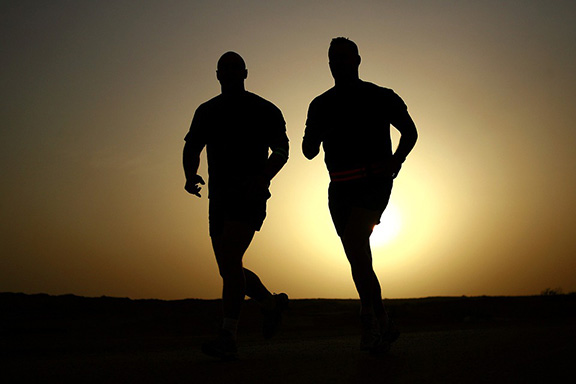May 19, 2021Tips to Run in the Summer Heat Effectively
As the temperature begins to heat up, which may draw out many runners from their winter hibernations with their indoor treadmills, it’s important to get those miles in while being aware of heat-related illness.
Hot and humid weather warrants caution and recalibration for runners looking to maintain their fitness routine, says exercise physiologist Katie Lawton, MEd, in a recent interview with Health.ClevelandClinic.org.
 Below is an excerpt from the tips Lawton shared to help runners stay safe while keeping up with their training schedule.
Below is an excerpt from the tips Lawton shared to help runners stay safe while keeping up with their training schedule.
Best Time to Run in Heat
The coolest part of the day typically occurs around sunrise, so rising before dawn to run works as an ideal solution to beat the heat. Evening runs also offer a bit of a respite from the heat, even if the temperatures don’t dip as low as in the AM hours.
Either time slot offers more ideal running conditions than midday when daily temperatures crest and the sun punishes those moving below. “Some people can do it,” Lawton says, “but you won’t find me running at 1 PM.”
What to Wear
There’s an outfit for every occasion, including a 5-miler under the summer sun. Running shirts and shorts for a hot day should be:
- Loose-fitting or vented to allow air to pass over and cool your skin.
- Made of a moisture-wicking fabric (typically polyester-based) to aid the evaporation process. Avoid cotton garments, which quickly turn into heavy, wet apparel that traps heat against your body.
- Light-colored, as dark hues absorb the sun’s heat.
Finding the Right Pace
Running on a blistering hot day brings a definite physiological response. Your heart rate spikes as your body works to combat the effects of overheating. This survival mode instinct diverts energy away from muscles to focus on cooling. Every sweaty step will take more effort as fatigue builds – and that will be reflected in your pace. For every 5-degree increase above 60 degrees, the typical runner can expect to slow 20 to 30 seconds per mile.
On the hottest days, Lawton suggests that you should ignore your pace-tracking GPS watch and run more by effort: “It’s a mindset adjustment,” she says. “Go by how you feel.”
How to Hydrate
Runners don’t just drip sweat when the weather heats up. They gush it. The mass loss of fluid can lead to dehydration if you don’t take proper steps before and after your workout.
Make sure to drink 16-20 ounces of water or sports drink a few hours ahead of any training run or race, Lawton says. Top that off by downing another 8-12 ounces within 15 minutes of the activity.
Plan on drinking fluids during any run lasting longer than an hour. Lawton said a good rule of thumb is to try to consume 3-5 ounces of liquid every 30 minutes of exertion.
To see all of the tips from Lawton on how to schedule your summer running schedule around the heat, click here.


